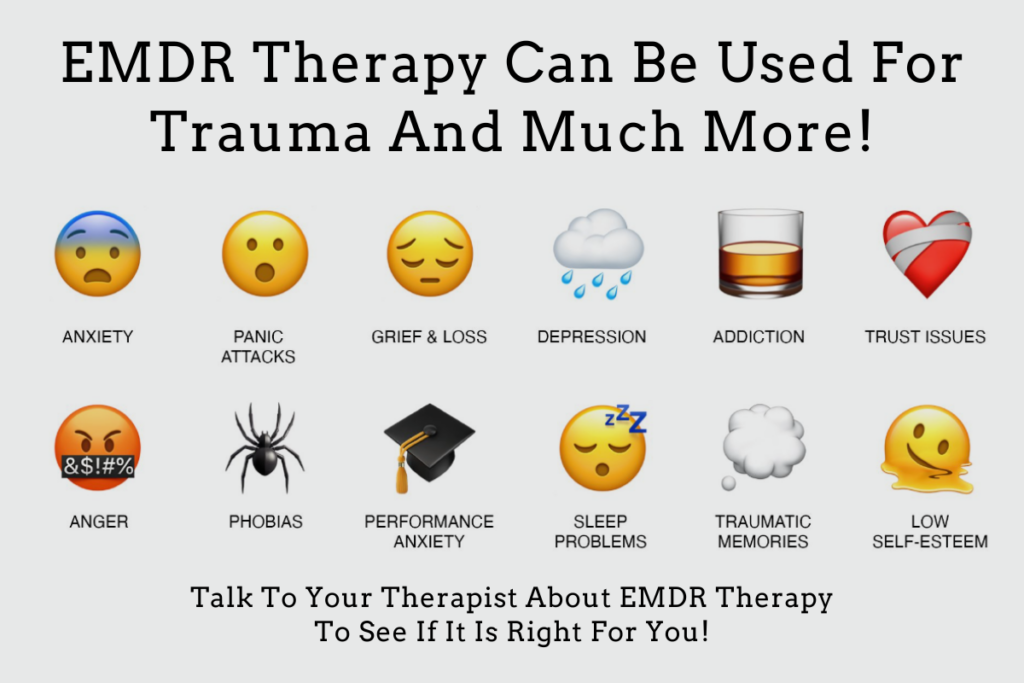EMDR Therapy For Scam Victims’ Trauma – A Part Of The Recovery Process For Many
Helping Scam Victims Understand A Form Of Effective Therapy That May Help Them
SCARS Recovery Psychology
Authors:
• Vianey Gonzalez B.Sc(Psych) – Licensed Psychologist Specialty in Crime Victim Trauma Therapy, Neuropsychologist, Certified Deception Professional, Psychology Advisory Panel & Director of the Society of Citizens Against Relationship Scams Inc.
• Tim McGuinness, Ph.D. – Anthropologist, Scientist, Director of the Society of Citizens Against Relationship Scams Inc.
• Portions from additional sources, including the U.S. Department of Veterans Affairs, Veterans Health Administration
About This Article
Scam victims often endure profound psychological trauma, experiencing symptoms such as anxiety, depression, and post-traumatic stress disorder (PTSD). Seeking effective treatment to address their trauma is crucial for recovery.
Emerging as a promising therapeutic approach, Eye Movement Desensitization and Reprocessing (EMDR) therapy offers scam victims a path toward healing and restoration. EMDR therapy enables individuals to process traumatic memories and associated distressing emotions in a safe and structured environment.
Through bilateral stimulation, such as eye movements, individuals can reprocess traumatic experiences, alleviate distressing symptoms, and foster adaptive coping mechanisms. EMDR therapy empowers scam victims to confront and resolve the lingering effects of their victimization, promoting resilience and reclaiming a sense of control over their lives.
By accessing this evidence-based treatment modality, scam victims can embark on a journey of healing, reclaiming their well-being, and rebuilding their lives after experiencing the devastating impact of fraud and exploitation.
EMDR Therapy – Eye Movement Desensitization and Reprocessing is an Approach Designed to Help Scam Victims Process Traumatic or Distressing Memories, Beliefs, and Emotions Associated with Traumatic Experiences such as Relationship Scams
What is EMDR Therapy?
Eye Movement Desensitization and Reprocessing (EMDR) therapy is a therapeutic approach designed to help scam victims (or anyone else) process traumatic or distressing memories, beliefs, and emotions associated with traumatic experiences such as romance scams, crypto investment scams, or other trust-based scams, especially where betrayal trauma was the result.
EMDR Therapy was developed by psychologist Francine Shapiro in the late 1980s, EMDR is particularly effective in treating trauma and post-traumatic stress disorder (PTSD) but can also be used for various other mental health conditions.
EMDR Therapy Involves the Following Key Components
- Desensitization: The therapist guides the scam victim in recalling distressing memories while simultaneously stimulating bilateral sensory input, typically through side-to-side eye movements, hand tapping, or auditory tones. This dual attention process helps to reduce the emotional charge and physiological arousal associated with the traumatic memories.
- Reprocessing: During desensitization, the scam victim’s cognitive processing is facilitated, allowing for the integration of new, more adaptive information and beliefs about the traumatic event (the crime.) This reprocessing phase aims to shift negative beliefs and emotions associated with the trauma towards more positive and realistic perspectives.
- Installation: Positive beliefs and emotions that emerge during reprocessing are strengthened and “installed” to replace the previously held negative beliefs. This helps scam victims develop a sense of empowerment, resilience, and self-efficacy in relation to the traumatic experience.
- Body Scan: Towards the end of the session, scam victims are guided through a body scan to identify any residual tension or discomfort associated with the trauma. This helps to ensure that the processing is complete and that the scam victim feels grounded and calm.
- Closure: At the end of each session, the therapist ensures that the scam victim feels stable and grounded before concluding the session. Homework assignments or self-regulation techniques may be provided to support ongoing coping and integration between sessions.
How is EMDR Therapy Provided
EMDR therapy is typically delivered over a series of sessions, with the exact number depending on the scam victim’s needs and the complexity of their trauma history (including past traumas.) It is a structured and evidence-based approach that has been widely researched and shown to be effective in reducing trauma and PTSD symptoms, improving emotional regulation, and enhancing overall well-being.
The Desensitization Component in EMDR Therapy
The Desensitization component in Eye Movement Desensitization and Reprocessing (EMDR) therapy is a crucial phase designed to help scam victims process distressing memories and emotions associated with traumatic experiences. During this phase, the therapist guides the scam victim in recalling the traumatic memory while simultaneously stimulating bilateral sensory input.
Key aspects of the Desensitization component include:
- Recalling Traumatic Memories: The therapist helps the scam victim to vividly recall the traumatic memory or memories that are causing distress. This may involve recounting specific details of the event, including sights, sounds, sensations, and emotions.
- Bilateral Stimulation: While recalling the traumatic memory, the therapist facilitates bilateral sensory stimulation to engage both hemispheres of the brain. This can be achieved through various means, such as side-to-side eye movements, hand tapping, or auditory tones. The purpose of bilateral stimulation is to create a state of dual attention, which can help to reduce the emotional intensity and physiological arousal associated with the traumatic memory.
- Processing Sensations and Emotions: As the scam victim engages in bilateral stimulation while recalling the traumatic memory, they may experience a range of sensations, emotions, and insights. These may include feelings of discomfort, sadness, fear, anger, or even moments of clarity and understanding.
- Dual Attention: The simultaneous focus on both the traumatic memory and the bilateral stimulation creates a state of dual attention, which can facilitate cognitive processing and emotional regulation. This dual attention allows the scam victim to maintain a connection with the present moment while also accessing and processing the traumatic memory.
- Safe Environment: Throughout the Desensitization phase, the therapist creates a safe and supportive environment for the scam victim. The scam victim is encouraged to express any thoughts, feelings, or sensations that arise during the process, knowing that they are in a non-judgmental and empathetic therapeutic space.
The Desensitization component of EMDR therapy is often experienced as a gradual reduction in the emotional charge and distress associated with the traumatic memory. Over time, scam victims may notice a shift in their emotional reactions and beliefs about the traumatic event, leading to a sense of resolution and relief. This phase sets the stage for subsequent phases of reprocessing and integration, ultimately promoting healing and recovery from trauma.
The Reprocessing Component of EMDR Therapy
The Reprocessing component of Eye Movement Desensitization and Reprocessing (EMDR) therapy involves the cognitive processing and integration of distressing memories and associated emotions, beliefs, and sensations. During this phase, scam victims work with their therapist to reprocess the targeted traumatic memories using bilateral stimulation while focusing on adaptive cognitions and emotions.
Key aspects of the Reprocessing component include:
- Target Identification: The therapist helps the scam victim identify specific traumatic memories, beliefs, and sensations that are the focus of reprocessing. These targets are typically identified based on the scam victim’s distress level, relevance to current symptoms, and impact on daily functioning.
- Bilateral Stimulation: Similar to the Desensitization phase, bilateral stimulation is used to facilitate reprocessing. The scam victim engages in side-to-side eye movements, hand tapping, or auditory tones while simultaneously recalling the targeted traumatic memory and associated thoughts and emotions.
- Dual Attention: The dual attention created by bilateral stimulation allows the scam victim to maintain a connection with the present moment while accessing and reprocessing the traumatic memory. This dual attention facilitates cognitive processing and emotional regulation, enabling the scam victim to integrate new insights and perspectives.
- Cognitive Restructuring: Throughout the Reprocessing phase, the therapist guides the scam victim in challenging and reframing maladaptive beliefs and interpretations associated with the traumatic memory. By examining the evidence for and against these beliefs, the scam victim can develop more balanced and adaptive perspectives.
- Affect Regulation: The therapist helps the scam victim regulate their emotions during the reprocessing of traumatic memories. Techniques such as grounding exercises, deep breathing, and positive self-talk may be used to manage emotional distress and promote a sense of safety and calmness.
- Integration and Resolution: As the scam victim engages in reprocessing, they may experience shifts in their emotional reactions, beliefs, and sensations related to the traumatic memory. Over time, these shifts lead to a sense of resolution, closure, and adaptive functioning.
- Future Template: Towards the end of the Reprocessing phase, the therapist works with the scam victim to develop a positive future template or image of themselves. This involves envisioning a future free from the constraints of the traumatic memory and filled with hope, resilience, and empowerment.
The Reprocessing component of EMDR therapy is a crucial stage in the healing process, allowing scam victims to reprocess and integrate traumatic memories in a safe and supportive therapeutic environment. By engaging in cognitive restructuring, affect regulation and dual attention, scam victims can experience profound shifts in their perception of themselves and their traumatic experiences, ultimately promoting healing, resilience, and post-traumatic growth.
The Installation Component of EMDR Therapy
The Installation component of Eye Movement Desensitization and Reprocessing (EMDR) therapy involves reinforcing positive beliefs, emotions, and sensations to replace negative or maladaptive ones associated with traumatic memories. This phase focuses on strengthening adaptive cognitions and emotions to promote healing and resilience.
Key aspects of the Installation component include:
- Positive Cognition Identification: The therapist helps the scam victim identify positive beliefs or affirmations that they want to instill as replacements for negative beliefs associated with the traumatic memory. These positive cognitions are typically framed in the present tense and are relevant to the scam victim’s sense of safety, self-worth, and empowerment.
- Positive Affect Activation: The scam victim is guided to access and amplify positive emotions and sensations associated with the identified positive cognitions. This may involve recalling past experiences or imagining future scenarios that evoke feelings of confidence, strength, and self-compassion.
- Bilateral Stimulation: Similar to the Reprocessing phase, bilateral stimulation is used to facilitate the installation of positive cognitions and emotions. The scam victim engages in side-to-side eye movements, hand tapping, or auditory tones while simultaneously focusing on the positive beliefs and emotions.
- SUDS Rating: Subjective Units of Disturbance (SUDS) rating is used to assess the scam victim’s level of distress associated with the positive cognition. The therapist asks the scam victim to rate their belief in the positive cognition on a scale from 1 to 7, with 1 indicating low belief and 7 indicating high belief.
- Desensitization: Through repeated sets of bilateral stimulation, the scam victim experiences a reduction in the disturbance associated with positive cognition. Negative emotions and sensations linked to the traumatic memory are gradually replaced by feelings of confidence, safety, and self-empowerment.
- Body Scan: The therapist guides the scam victim through a body scan to identify any remaining tension, discomfort, or resistance associated with the positive cognition. This allows the scam victim to release any lingering negative energy and fully embrace the positive belief.
- Positive Installation: As the scam victim experiences a shift in their belief and emotional response, the therapist reinforces the positive cognition through verbal affirmation and validation. The scam victim is encouraged to internalize the positive belief and integrate it into their sense of self.
- Closure: Once the positive cognition has been installed and strengthened, the therapist ensures that the scam victim feels grounded, calm, and centered. Any remaining distress or discomfort is addressed, and the session is brought to a close in a supportive and affirming manner.
The Installation component of EMDR therapy aims to consolidate the gains made during the Reprocessing phase by embedding positive beliefs and emotions into the scam victim’s psyche. By strengthening adaptive cognitions and emotions, scam victims can experience a profound shift in their perception of themselves and their ability to cope with traumatic experiences. This fosters resilience, empowerment, and post-traumatic growth, laying the foundation for lasting healing and well-being.
The Body Scan Component of EMDR Therapy
In Eye Movement Desensitization and Reprocessing (EMDR) therapy, the Body Scan component is a technique used to help scam victims identify and process any physical sensations, discomfort, or tension associated with traumatic memories or distressing emotions. This component aims to promote greater awareness of the mind-body connection and facilitate the release of somatic (bodily) responses to trauma.
Here’s how the Body Scan component typically works within the context of EMDR therapy:
- Identification of Bodily Sensations: The therapist guides the scam victim to focus their attention inward and become aware of any physical sensations they are experiencing in their body. These sensations may include tension, tightness, discomfort, warmth, coldness, tingling, or numbness.
- Observation without Judgment: The scam victim is encouraged to observe their bodily sensations without judgment or interpretation. They learn to cultivate a curious and accepting attitude towards whatever sensations arise, recognizing that these sensations are natural responses to trauma.
- Mapping Sensations to Trauma: The therapist helps the scam victim explore the connection between their bodily sensations and specific traumatic memories, emotions, or triggers. By linking bodily experiences to underlying psychological processes, the scam victim gains insight into the somatic manifestations of trauma.
- Bilateral Stimulation: Similar to other phases of EMDR therapy, bilateral stimulation may be used during the Body Scan to facilitate the processing of somatic experiences. The scam victim engages in side-to-side eye movements, hand tapping, or auditory tones while focusing on their bodily sensations and associated traumatic memories.
- Tracking Changes: Throughout the Body Scan, the scam victim is encouraged to notice any changes in their bodily sensations as they engage in bilateral stimulation and process traumatic material. They may observe shifts in intensity, location, or quality of sensations, indicating the release of stored tension or emotion.
- Integration and Grounding: As the Body Scan progresses, the therapist helps the scam victim integrate their somatic experiences with cognitive and emotional insights gained during EMDR therapy. Grounding techniques, such as deep breathing or progressive muscle relaxation, may be used to promote a sense of safety and stability.
- Closure: Once the Body Scan is complete, the therapist ensures that the scam victim feels grounded and present in the here and now. Any residual tension or discomfort is addressed, and the session is brought to a close in a supportive and reassuring manner.
The Body Scan component of EMDR therapy enhances the scam victim’s awareness of how trauma is stored and expressed in the body, allowing for a more holistic approach to healing. By processing somatic responses to trauma alongside cognitive and emotional material, scam victims can achieve greater integration and resolution of their traumatic experiences, leading to increased well-being and resilience.
The Closure Component of EMDR Therapy
The Closure component of Eye Movement Desensitization and Reprocessing (EMDR) therapy is a structured procedure designed to ensure that each therapy session ends in a safe and stable manner. Closure is essential for helping scam victims feel grounded and secure after engaging in the intensive processing of traumatic material during EMDR therapy sessions.
Here’s how the Closure component typically unfolds within the context of EMDR therapy:
- Review of Progress: Before initiating closure, the therapist and the scam victim review the progress made during the session. They may discuss any insights, shifts in awareness, or processing experiences that occurred while addressing targeted traumatic memories or distressing emotions.
- Grounding Techniques: The therapist guides the scam victim in using grounding techniques to transition from the intense processing phase of EMDR therapy to a calmer state of mind. Grounding techniques may include deep breathing exercises, progressive muscle relaxation, mindfulness techniques, or visualization exercises.
- Return to Present Awareness: The scam victim is encouraged to focus on their immediate surroundings and sensations, reorienting themselves to the present moment. The therapist may prompt the scam victim to notice sensory details in the therapy room, such as the feel of the chair beneath them or the sound of their breathing.
- Positive Resource Installation: In some cases, Closure may involve reinforcing positive internal resources or coping skills that the scam victim can utilize between sessions. The therapist may guide the scam victim in recalling a time when they felt safe, competent, or empowered, and help them anchor that positive experience in their mind.
- Review of Coping Strategies: The therapist and the scam victim review any coping strategies discussed or practiced during the session, emphasizing their relevance for managing distress outside of therapy. This may include relaxation techniques, self-soothing activities, or cognitive coping strategies.
- Discussion of Aftercare: Closure provides an opportunity for the therapist to discuss aftercare strategies with the scam victim, such as self-care practices, emotional regulation techniques, or crisis management plans. The scam victim is encouraged to engage in activities that promote self-soothing and emotional well-being between sessions.
- Check-In: The therapist checks in with the scam victim to assess their current emotional state and level of distress. Any lingering discomfort or unresolved issues are addressed, and the scam victim is reassured of their safety and stability.
- Scheduling Next Session: Closure concludes with scheduling the next EMDR therapy session, ensuring continuity of care and ongoing progress in the therapeutic process. The therapist may also provide guidance on activities or reflections to engage in before the next session.
The Closure component of EMDR therapy serves as a crucial step in integrating the processing work done during sessions and promoting a sense of containment and safety for the scam victim. By facilitating a smooth transition from therapy back to daily life, Closure helps scam victims feel empowered and supported in their journey toward healing from trauma.
How Does EMDR Therapy Work?
Eye Movement Desensitization and Reprocessing (EMDR) therapy is an evidence-based psychotherapy approach designed to help scam victims process distressing memories, thoughts, and emotions associated with traumatic experiences. Developed by Dr. Francine Shapiro in the late 1980s, EMDR therapy integrates elements of cognitive-behavioral therapy (CBT), exposure therapy, and bilateral stimulation to facilitate the adaptive processing of traumatic material.
The precise mechanism of action of EMDR therapy is still under investigation, but several theories have been proposed to explain how it works:
- Information Processing Model: According to this model, traumatic experiences overwhelm the brain’s natural processing capacity, leading to the incomplete encoding and storage of memories. EMDR therapy helps facilitate the reprocessing of traumatic memories by accessing and integrating them into existing memory networks. Bilateral stimulation, such as eye movements, taps, or auditory tones, is believed to facilitate the adaptive processing of traumatic material by engaging the brain’s information-processing system.
- Dual Attention Hypothesis: The dual attention hypothesis suggests that engaging in bilateral stimulation while recalling traumatic memories diverts attention away from the distressing material, allowing scam victims to access and process the memories more effectively. This dual focus on the traumatic memory and the external stimulus (e.g., eye movements) is thought to promote cognitive flexibility and reduce the emotional intensity associated with the memory.
- Memory Reconsolidation: EMDR therapy may facilitate the reconsolidation of traumatic memories by promoting the integration of new information or perspectives. By accessing traumatic memories during therapy sessions and pairing them with bilateral stimulation, scam victims may have opportunities to update their cognitive and emotional responses to the memories, leading to a reduction in distress and the development of more adaptive coping mechanisms.
- Physiological Effects: Bilateral stimulation used in EMDR therapy, such as eye movements or tactile sensations, may have physiological effects on the brain and nervous system. Some research suggests that bilateral stimulation can modulate arousal levels, regulate emotional responses, and promote relaxation, which may contribute to the therapeutic benefits observed in EMDR therapy.
- Resource Enhancement: In addition to processing traumatic memories, EMDR therapy emphasizes the identification and strengthening of internal resources and coping skills. Positive resources, such as feelings of safety, self-efficacy, and social support, are integrated into the therapeutic process to enhance resilience and facilitate recovery from trauma.
EMDR therapy is believed to work by facilitating the adaptive processing of traumatic memories, reducing the emotional intensity associated with these memories, and promoting cognitive restructuring and emotional healing. By engaging in structured bilateral stimulation and guided processing of traumatic material, scam victims can experience symptom relief, increased self-awareness, and a greater sense of empowerment in their recovery from trauma.
What Can You Expect?
When beginning Eye Movement Desensitization and Reprocessing (EMDR) therapy, scam victims can expect a structured and collaborative process aimed at addressing distressing memories, thoughts, and emotions associated with traumatic experiences.
Here’s what scam victims can typically anticipate during EMDR therapy:
- Assessment and Preparation: The therapist begins by conducting a comprehensive assessment to gather information about the scam victim’s history, symptoms, and trauma-related experiences. This initial phase also involves establishing rapport, discussing treatment goals, and providing education about EMDR therapy.
- Resource Development: Before delving into trauma processing, the therapist helps the scam victim identify and strengthen internal resources and coping skills. These resources may include feelings of safety, relaxation techniques, supportive relationships, and positive self-statements. Building a foundation of resources helps scam victims manage distress during EMDR processing and fosters resilience.The self-statements that SCARS uses as a part of its support process are:
- ‘I am a survivor’
- ‘It was not my fault’
- ‘I am not alone’
- ‘Axios’
- Target Selection: Together with the therapist, the scam victim identifies specific traumatic memories, negative beliefs, and associated emotions or sensations to target in EMDR therapy. These targets serve as focal points for processing and are addressed one at a time, starting with less distressing memories before progressing to more challenging ones.
- Desensitization and Reprocessing: During the desensitization phase, the scam victim recalls the targeted traumatic memory while simultaneously engaging in bilateral stimulation, such as following the therapist’s finger movements or listening to auditory tones. This dual attention facilitates the processing of the memory, allowing the scam victim to access and integrate new information, emotions, and perspectives. As the memory is reprocessed, its emotional intensity typically decreases, and the scam victim may experience insights, shifts in beliefs, or emotional release.
- Body Scan: After reprocessing the memory, the therapist guides the scam victim through a body scan to identify any residual tension, discomfort, or physical sensations associated with the memory. The scam victim learns to notice and release bodily reactions while maintaining a sense of safety and grounding.
- Closure: Each EMDR therapy session concludes with a structured closure process to ensure the scam victim feels grounded and emotionally stable before leaving the session. This may involve relaxation exercises, deep breathing, or reviewing coping strategies. The therapist reassures the scam victim that they can continue processing between sessions and provides guidance for self-care.
- Reevaluation and Follow-Up: Throughout the course of EMDR therapy, the therapist periodically assesses the scam victim’s progress, evaluates treatment goals, and adjusts the treatment plan as needed. Follow-up sessions may focus on addressing any residual symptoms, consolidating gains, and integrating insights from processing experiences.
Scam victims can expect EMDR therapy to be a collaborative, evidence-based approach to trauma treatment that offers opportunities for healing, insight, and emotional growth. While the process may initially evoke strong emotions or discomfort, many scam victims report significant improvements in symptoms and well-being as they progress through treatment.
Is EMDR Effective?
Eye Movement Desensitization and Reprocessing (EMDR) therapy has been extensively researched and demonstrated effectiveness in treating traumatized scam victims, including those with post-traumatic stress disorder (PTSD) and other trauma-related conditions. Numerous studies have shown that EMDR therapy can lead to significant reductions in symptoms and improvements in overall well-being.
Here are some Key Findings regarding the Effectiveness of EMDR therapy:
- Reduction in PTSD Symptoms: EMDR therapy has been found to significantly reduce symptoms of trauma and PTSD, including intrusive thoughts, nightmares, hypervigilance, and avoidance behaviors. Research studies have consistently reported substantial decreases in PTSD symptom severity following EMDR treatment.
- Improvements in Anxiety and Depression: Beyond PTSD symptoms, EMDR therapy has been associated with reductions in comorbid conditions such as anxiety and depression. Many scam victims receiving EMDR treatment experience improvements in mood, overall functioning, and quality of life.
- Long-Term Benefits: Research suggests that the benefits of EMDR therapy are often sustained over time, with many scam victims maintaining symptom improvements months or even years after completing treatment. Long-term follow-up studies have demonstrated the durability of treatment gains and the prevention of symptom relapse.
- Effectiveness Across Populations: EMDR therapy is effective across diverse populations, including adults, adolescents, and children. It has been used successfully with scam victims who have experienced various types of trauma, including crime victims, combat-related trauma, interpersonal violence, natural disasters, and childhood abuse.
- Comparative Effectiveness: Some studies have compared EMDR therapy to other evidence-based treatments for PTSD, such as cognitive-behavioral therapy (CBT) and exposure therapy. While findings vary across studies, research generally supports the efficacy of EMDR therapy, with some studies suggesting comparable effectiveness to other treatments.
- Acceptance and Satisfaction: Many scam victims report high levels of satisfaction and acceptance of EMDR therapy. Scam Victims often appreciate the structured and focused nature of the treatment, as well as its ability to rapidly alleviate distressing symptoms associated with trauma.
The evidence supports the effectiveness of EMDR therapy as a viable treatment option for traumatized scam victims. However, it’s essential to recognize that therapy outcomes can vary depending on factors such as the scam victim’s readiness for treatment and the commitment to the therapy, the quality of the therapeutic relationship, and the skill and experience of the therapist. As with any form of psychological therapy, successful outcomes often depend on a collaborative approach between the scam victim and the therapist.
How Long Does EMDR Therapy Last?
The duration of Eye Movement Desensitization and Reprocessing (EMDR) therapy can vary depending on several factors, including the nature and severity of the trauma, the scam victim’s scam victim needs and goals, and the therapist’s treatment approach. While some scam victims may experience significant relief from symptoms in a relatively short period, others may require more extensive treatment.
Generally, EMDR therapy is structured to be a time-limited intervention, with a typical course consisting of 8 to 12 sessions. However, this is just an average estimate, and the actual number of sessions needed can vary widely. Some scam victims may achieve their treatment goals in fewer sessions, while others may require more sessions to address complex or multiple traumas thoroughly.
Factors influencing the duration of EMDR therapy include:
- Severity of Trauma: Scam Victims who have experienced severe or multiple traumatic events may require more sessions to process and integrate their experiences fully.
- Treatment Goals: The number of sessions needed may also depend on the specific treatment goals identified by the scam victim and therapist. Scam Victims with a narrow focus or specific trauma-related symptoms may require fewer sessions than those with broader treatment goals.
- Client Readiness and Resilience: Scam Victims’ readiness to engage in therapy and their level of emotional resilience can influence the pace and effectiveness of EMDR treatment. Some scam victims may progress more quickly through therapy due to their readiness to confront and process traumatic memories, while others may require more time to build coping skills and establish a sense of safety.
- Therapeutic Relationship: The quality of the therapeutic relationship between the scam victim and therapist can impact the pace and effectiveness of EMDR therapy. A strong therapeutic alliance characterized by trust, empathy, and collaboration may facilitate faster progress and better outcomes.
- Integration and Follow-Up: After completing the initial phase of EMDR therapy, scam victims may benefit from follow-up sessions to monitor progress, address any residual symptoms, and reinforce gains. The integration of insights and changes made during therapy into daily life may also influence the duration of treatment.
Ultimately, the length of EMDR therapy is scam victimized and may be adjusted based on ongoing assessment and feedback from both the scam victim and therapist. Scam Victims need to discuss their treatment progress and goals with their therapist regularly to ensure that therapy remains focused and effective.
Can a Scam Victim do EMDR Therapy on their own as a Self-Help Technique?
While EMDR therapy is typically conducted by trained mental health professionals, there are some self-help techniques inspired by EMDR principles that scam victims can use on their own. However, it’s important to note that self-administered EMDR techniques may not replicate the full therapeutic benefits of formal EMDR therapy conducted by a licensed therapist.
Here are some Self-Help Techniques inspired by EMDR principles:
- Bilateral Stimulation: Bilateral stimulation involves stimulating both sides of the brain alternately, which is a key component of EMDR therapy. Individuals can replicate this by tapping alternating sides of their body, such as tapping their knees or shoulders alternately with their hands. They can also use tools like bilateral music or auditory tones that alternate between the left and right ears.
- Imaginal Exposure: Imaginal exposure involves mentally revisiting traumatic memories while simultaneously engaging in bilateral stimulation. Individuals can try to visualize the traumatic event in detail while using bilateral tapping or eye movements to mimic the bilateral stimulation used in EMDR therapy. This technique may help desensitize the scam victim to the traumatic memories over time.
- Self-Evaluation of Thoughts: EMDR therapy involves identifying and challenging negative thoughts and beliefs related to the traumatic event. Individuals can practice self-reflection and cognitive restructuring by identifying their negative thoughts about the trauma and challenging them with more adaptive perspectives. Writing down these thoughts and counterarguments can be helpful.
- Relaxation Techniques: EMDR therapy often incorporates relaxation techniques to help scam victims manage distress during and after processing traumatic memories. Self-help relaxation techniques such as deep breathing, progressive muscle relaxation, and guided imagery can be beneficial in reducing anxiety and promoting a sense of calmness.
- Mindfulness Practices: Mindfulness techniques, such as mindfulness meditation and body scanning, can help scam victims cultivate present-moment awareness and non-judgmental acceptance of their experiences. Mindfulness practices can complement EMDR therapy by enhancing emotional regulation and reducing reactivity to trauma triggers.
While these self-help techniques may offer some relief and support for scam victims dealing with trauma-related symptoms, they are not a substitute for professional EMDR therapy conducted by a trained therapist. EMDR therapy involves a structured treatment protocol tailored to the scam victim’s specific needs, and a therapist can provide guidance, support, and personalized interventions throughout the treatment process. Additionally, EMDR therapy may uncover intense emotions or memories that require the expertise of a therapist to navigate safely and effectively. Therefore, scam victims considering EMDR therapy for trauma recovery are encouraged to seek guidance from a qualified mental health professional.
NOTE:
While it is possible to do EMDR on your own, it will not have the same benefit as when it is done with a trained therapist. SCARS recommends that you see a trauma therapist to employ this specific therapy. However, if you are unable to see a therapist then this may provide help until such time as you can.
How to do EMDR Therapy on your own
While Eye Movement Desensitization and Reprocessing (EMDR) therapy is typically administered by trained mental health professionals, there are self-help techniques inspired by EMDR principles that scam victims can try on their own. It’s essential to approach self-administered EMDR techniques with caution and to recognize that they may not replicate the full therapeutic benefits of formal EMDR therapy conducted by a licensed therapist.
Here’s a basic outline of steps and techniques for self-administered EMDR-inspired therapy:
- Preparation:
- Find a quiet and comfortable space where you won’t be disturbed.
- Set aside dedicated time for the practice.
- Have paper and pen nearby for journaling.
- Identification of Target Memory:
- Identify a specific traumatic memory or distressing event to target for processing.
- Choose a memory that is manageable in intensity and not overwhelming to start with.
- Bilateral Stimulation:
- Bilateral stimulation involves alternately stimulating both sides of the brain, which is a core component of EMDR therapy.
- You can mimic bilateral stimulation by tapping alternating sides of your body (e.g., tapping your knees or shoulders alternately with your hands).
- Alternatively, you can use bilateral audio stimulation, such as listening to music or tones that alternate between the left and right ears.
- Visualization and Exposure:
- Close your eyes and visualize the traumatic memory or distressing event as vividly as you can.
- Allow yourself to experience the emotions and sensations associated with the memory.
- While holding the memory in your mind, engage in bilateral stimulation (e.g., tapping or auditory stimulation).
- Desensitization:
- As you continue to visualize the memory and engage in bilateral stimulation, notice any changes in the intensity of the emotions or sensations.
- Pay attention to any shifts in your emotional or physical responses as you process the memory.
- Cognitive Restructuring:
- Challenge any negative thoughts or beliefs associated with the memory.
- Identify and replace unhelpful thoughts with more balanced and realistic perspectives.
- Write down any new insights or reframed beliefs in your journal.
- Body Scan:
- Conduct a body scan to check in with your physical sensations.
- Notice any tension, discomfort, or areas of stress in your body.
- Use relaxation techniques, such as deep breathing or progressive muscle relaxation, to release tension and promote relaxation.
- Closure:
- Once you feel you have processed the memory to a manageable level, gradually transition out of the exercise.
- Take some time to engage in self-care activities, such as going for a walk, listening to calming music, or practicing mindfulness.
- Reflection:
- After the session, reflect on your experience and any insights gained.
- Write down your reflections in your journal, including any changes in your emotional state or perceptions of the memory.
It’s important to approach self-administered EMDR-inspired therapy with self-compassion and patience. If you find that the process is overwhelming or if you encounter intense emotions or memories that you’re unable to manage on your own, consider seeking support from a licensed mental health professional who is trained in EMDR therapy. They can provide guidance, support, and personalized interventions to help you navigate the healing process safely and effectively.
Summary
EMDR therapy offers a powerful and transformative healing process for scam victims who have experienced trauma, providing a pathway toward resolution, integration, and recovery.
If you have not spoken with your therapist about EMDR Therapy, we suggest that you do so during your next session.
Please Rate This Article
Please Leave Us Your Comment
Also, tell us of any topics we might have missed.
Leave a Reply
Thank you for your comment. You may receive an email to follow up. We never share your data with marketers.
-/ 30 /-
What do you think about this?
Please share your thoughts in a comment above!
More Therapy Related Information:
- Cognitive Processing Therapy (CPT) For Scam Victims – 2024 (scamsnow.com)
- Scam Victims Guide To Do-It-Yourself Exposure Therapy – 2024 (scamsnow.com)
- The Unique Injury Of Betrayal Trauma On Scam Victims – 2024 (scamsnow.com)
- Trauma And Grief In Scam Victims – What Is The Difference Between Them – 2024 (scamsnow.com)
- A Typical Scam Victim Journey Through Recovery Challenges – 2024 (scamsnow.com)
- Alfred Adler Approach To Psychology To Scam Victims And How They Were Affected – 2024 (scamsnow.com)
- Scam Victims In The RAIN – A Mindfulness Approach For Recovery – 2024 (scamsnow.com)
- Scam Victims Guide To Do-It-Yourself EFT Tapping – 2024 (scamsnow.com)
- Helping Scam Victims Understand Cognitive Dissonance – 2024 (scamsnow.com)
-/ 30 /-
What do you think about this?
Please share your thoughts in a comment above!
SCARS LINKS: AgainstScams.org RomanceScamsNOW.com ContraEstafas.org ScammerPhotos.com Anyscam.com ScamsNOW.com
reporting.AgainstScams.org support.AgainstScams.org membership.AgainstScams.org donate.AgainstScams.org shop.AgainstScams.org
youtube.AgainstScams.org linkedin.AgainstScams.org facebook.AgainstScams.org
ARTICLE RATING
TABLE OF CONTENTS
CATEGORIES
MOST POPULAR COMMENTED ARTICLES
POPULAR ARTICLES
U.S. & Canada Suicide Lifeline 988
![NavyLogo@4x-81[1]](https://scamsnow.com/wp-content/uploads/2025/04/NavyLogo@4x-811.png)
ARTICLE META
WHAT PEOPLE ARE TALKING ABOUT LATEST SITE COMMENTS
See Comments for this Article at the Bottom of the Page
on Samurai Wisdom and Rituals for Clearing the Mind After Scam Trauma – 2025 – [VIDEOS]: “A great guide on how to move forward in our recovery process with a calm mind, cleansed on an ongoing…” Jun 28, 07:34
on Delayed Gratification and Patience in Scam Victim Recovery – 2025 – [VIDEOS]: “We want to recover quickly and… we make new mistakes. How not to speed up the recovery process, how to…” Jun 28, 06:41
on The Unique Injury Of Betrayal Trauma On Scam Victims – 2024: “Primarily because you did not see it coming” Jun 27, 23:57
on Changes In A Scam Victim’s Life: “I really detest the way my trust in others has been affected by the scamming I went through. I used…” Jun 27, 14:47
on The Unique Injury Of Betrayal Trauma On Scam Victims – 2024: “Betrayal Trauma is the worst feeling ever. Why does it seem so much worse when a scammer does that to…” Jun 27, 14:34
on EMDR Therapy For Scam Victims’ Trauma – A Part Of The Recovery Process For Many – 2024: “Very comprehensive article explaining all aspects of EMDR. I’d only heard of it before and now I have a much…” Jun 26, 19:01
on Forgiving Yourself After Surviving a Romance or Investment Scam – 2025: “Thank you for this valuable article. Self-forgiveness was for me the biggest step that led to my recovery. That also…” Jun 26, 17:28
on Counseling And Your Native Language: “These points make perfect sense. I can’t imagine trying to express complex emotions in a second language. I realize many…” Jun 26, 16:05
on Thought-Terminating Cliches – How What You and Others Say Stops Critical Thinking and Recovery for Scam Victims – 2025: “I didn’t realize that these “innocent phrases” clichés ending thoughts, can have such effect / negative -inhibiting / on our…” Jun 26, 14:48
on Scam Victim Resistance In Support Groups Therapy Or Counseling Can Destroy Opportunities For Recovery – 2024: “Working with either a support group or therapist to me means a self commitment to actively participating in the therapy.…” Jun 24, 21:01
on ‘I Just Want To Forget It’ – Denial & Avoidance Are Natural But Will Not Help Scam Victims On Their Path To Recovery From Scams – 2024: “My financial loss, the shock and betrayal of the crime ending all combined to fray my nerves and spend hours…” Jun 24, 20:10
on You Hate Being Told What To Do? How Your Rebellious Mentality Can Sabotage Your Recovery – 2025: “I am a bit of a rebel, and the moment someone tells me to do something, worse, does it even…” Jun 24, 15:04
on You Hate Being Told What To Do? How Your Rebellious Mentality Can Sabotage Your Recovery – 2025: “You are very welcome” Jun 24, 03:01
on You Hate Being Told What To Do? How Your Rebellious Mentality Can Sabotage Your Recovery – 2025: “This is a great article, which makes perfect sense as to why anyone would resist the help offered to them.…” Jun 23, 20:01
on Scam Victims’ Responsibilities – 2021 [Updated 2025]: “Thank you for this article. As I continue my journey, I focus on the here and now and let the…” Jun 21, 16:26
on Scam Victims Avoid Or Escape The Aftermath Of Scams – How Denial And Distraction Avoid Confronting Reality – 2024: “In the earliest days after my crime I felt powerless, helpless and weak. I had been through so much in…” Jun 21, 14:46
on Problems and Opportunities – Thoughts on Psychological Reframing – 2025: “An article that really helped me look at the problems in my life from a different point of view and…” Jun 21, 14:42
on Scam Victims Avoid Or Escape The Aftermath Of Scams – How Denial And Distraction Avoid Confronting Reality – 2024: “Thank you for another great article! This discussion of avoidance and other tactics some can use to deny the existence…” Jun 17, 12:20
on Helping Scam Victims Understand The Social Isolation Risks After A Relationship Scam – 2024: “This article very informatively shows the risk of social isolation especially after a scam. Although I can acknowledge the list…” Jun 17, 11:31
Important Information for New Scam Victims
Please visit www.ScamVictimsSupport.org – a SCARS Website for New Scam Victims & Sextortion Victims
SCARS Institute now offers a free recovery program at www.SCARSeducation.org
Please visit www.ScamPsychology.org – to more fully understand the psychological concepts involved in scams and scam victim recovery
If you are looking for local trauma counselors, please visit counseling.AgainstScams.org
If you need to speak with someone now, you can dial 988 or find phone numbers for crisis hotlines all around the world here: www.opencounseling.com/suicide-hotlines
Statement About Victim Blaming
Some of our articles discuss various aspects of victims. This is both about better understanding victims (the science of victimology) and their behaviors and psychology. This helps us to educate victims/survivors about why these crimes happened and not to blame themselves, better develop recovery programs, and help victims avoid scams in the future. At times, this may sound like blaming the victim, but it does not blame scam victims; we are simply explaining the hows and whys of the experience victims have.
These articles, about the Psychology of Scams or Victim Psychology – meaning that all humans have psychological or cognitive characteristics in common that can either be exploited or work against us – help us all to understand the unique challenges victims face before, during, and after scams, fraud, or cybercrimes. These sometimes talk about some of the vulnerabilities the scammers exploit. Victims rarely have control of them or are even aware of them, until something like a scam happens, and then they can learn how their mind works and how to overcome these mechanisms.
Articles like these help victims and others understand these processes and how to help prevent them from being exploited again or to help them recover more easily by understanding their post-scam behaviors. Learn more about the Psychology of Scams at www.ScamPsychology.org
SCARS INSTITUTE RESOURCES:
If You Have Been Victimized By A Scam Or Cybercrime
♦ If you are a victim of scams, go to www.ScamVictimsSupport.org for real knowledge and help
♦ Enroll in SCARS Scam Survivor’s School now at www.SCARSeducation.org
♦ To report criminals, visit https://reporting.AgainstScams.org – we will NEVER give your data to money recovery companies like some do!
♦ Follow us and find our podcasts, webinars, and helpful videos on YouTube: https://www.youtube.com/@RomancescamsNowcom
♦ Learn about the Psychology of Scams at www.ScamPsychology.org
♦ Dig deeper into the reality of scams, fraud, and cybercrime at www.ScamsNOW.com and www.RomanceScamsNOW.com
♦ Scam Survivor’s Stories: www.ScamSurvivorStories.org
♦ For Scam Victim Advocates visit www.ScamVictimsAdvocates.org
♦ See more scammer photos on www.ScammerPhotos.com
You can also find the SCARS Institute on Facebook, Instagram, X, LinkedIn, and TruthSocial
Psychology Disclaimer:
All articles about psychology and the human brain on this website are for information & education only
The information provided in this and other SCARS articles are intended for educational and self-help purposes only and should not be construed as a substitute for professional therapy or counseling.
Note about Mindfulness: Mindfulness practices have the potential to create psychological distress for some individuals. Please consult a mental health professional or experienced meditation instructor for guidance should you encounter difficulties.
While any self-help techniques outlined herein may be beneficial for scam victims seeking to recover from their experience and move towards recovery, it is important to consult with a qualified mental health professional before initiating any course of action. Each individual’s experience and needs are unique, and what works for one person may not be suitable for another.
Additionally, any approach may not be appropriate for individuals with certain pre-existing mental health conditions or trauma histories. It is advisable to seek guidance from a licensed therapist or counselor who can provide personalized support, guidance, and treatment tailored to your specific needs.
If you are experiencing significant distress or emotional difficulties related to a scam or other traumatic event, please consult your doctor or mental health provider for appropriate care and support.
Also read our SCARS Institute Statement about Professional Care for Scam Victims – click here
If you are in crisis, feeling desperate, or in despair, please call 988 or your local crisis hotline.
More ScamsNOW.com Articles
A Question of Trust
At the SCARS Institute, we invite you to do your own research on the topics we speak about and publish. Our team investigates the subject being discussed, especially when it comes to understanding the scam victims-survivors’ experience. You can do Google searches, but in many cases, you will have to wade through scientific papers and studies. However, remember that biases and perspectives matter and influence the outcome. Regardless, we encourage you to explore these topics as thoroughly as you can for your own awareness.
















![scars-institute[1]](https://scamsnow.com/wp-content/uploads/2025/04/scars-institute1.png)
![niprc1.png1_-150×1501-1[1]](https://scamsnow.com/wp-content/uploads/2025/04/niprc1.png1_-150x1501-11.webp)

Very comprehensive article explaining all aspects of EMDR. I’d only heard of it before and now I have a much better understanding of what it’s all about. I will have a discussion with my therapist about it. Thank you.
EMDR is coming up in my next session with my therapist. This in depth discussion of EMDR helped me to better understand what I will experience. My therapist gave me homework to write down at least 10 events that have contributed to my trauma over the years. She then asked to rate each item on the list with 1 being lowest in affecting me and 10 being the highest. We have a few things to work on. I’ve tried tapping before and did not find a benefit in it. It will be interesting to see if EMDR makes a difference for me.
Very interesting article. I have been doing this exercise with my therapist, and it really works.
Amazing! I am having this kind of therapy without knowing it was EMDR. I can say it is effective.